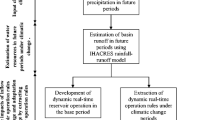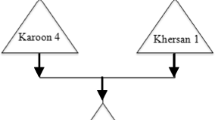Abstract
An increase in greenhouse gases in future can exacerbate the climate change phenomenon and may have negative consequences on different elements of hydrologic system, including rainfall, temperature, and streamflow. Since the reservoir operation is highly dependent on the timing and magnitude of inflow, the impact of potential climate change on inflow sequences should be considered in deriving the system operation rule. Nevertheless, existing algorithms are only able to optimize the operation policy for a single predetermined climate scenario. Thus, the derived operation rule would not work well if the scenario changes. This paper proposes an algorithm which is able to handle simultaneously multiple scenarios in finding optimum system operation rule. Thus, it can overcome drawbacks caused by uncertainties in the occurrence of future scenarios. The proposed algorithm is used to optimize reservoir operation policy considering various climate change scenarios (RCPs). To evaluate the performance of the proposed algorithm, a five-reservoir system within Tehran region with several objectives including municipal, agricultural, environmental, and hydropower demands is employed as the case study. Results show that in all cases the multi-scenario rule derived by the proposed method performs as good as the operation rule derived for any specific scenario using a powerful optimization algorithm when evaluated for that scenario. While, in all other models as the future scenario changes to the one other than that used in deriving the operation rule, the model performance declines as compared to the proposed model.




Similar content being viewed by others
References
Ahmadi M, Haddad OB, Loáiciga HA (2015) Adaptive reservoir operation rules under climatic change. Water Resour Manag 29(4):1247–1266
Arrow KJ (1951) Social choice and individual values. John Wiley & Sons, Inc
Arrow KJ, Sen AK, Suzumura K (2002) Handbook of social choice and welfare. Vol. 1. Elsevier, Amsterdam
Ashrafi SM, Dariane AB (2013) Performance evaluation of an improved harmony search algorithm for numerical optimization: melody search (MS). Eng Appl Artif Intell 26(4):1301–1321
Azmi M, Heidarzadeh N (2013) Dynamic modelling of integrated water resources quality management. Proc ICE - Water Manag 166(7):357–366
Black D (1948) On the rationale of group decision making. J Polit Econ 56(23–34)
de Borda JC (1781) Mathematical derivation of an election system. Isis 44:42–51 English translation by A. de Grazia in 1953
Chadwick R, Coppola E, Giorgi F (2011) An artificial neural network technique for downscaling GCM outputs to RCM spatial scale. Nonlinear Process Geophys 18(6):1013–1028
Che D, Mays LW (2017) Application of an optimization/simulation model for real-time flood-control operation of river-reservoirs systems. Water Resour Manag 31(7):2285–2297
Christensen NS, Wood AW, Voisin N, Lettenmaier DP, Palmer RN (2004) The effects of climate change on the hydrology and water resources of the Colorado River basin. Clim Chang 62(1):337–363
D’Angelo A, Eskandari A, Szidarovszky F (1998) Social choice procedures in water-resource management. J Environ Manag 52(3):203–210
Deb K, Jain H (2013) An evolutionary many-objective optimization algorithm using reference-point based non-dominated sorting approach, part II: handling constraints and extending to an adaptive approach. IEEE Trans Evol Comput 18(4):602–622
Ebert U, Welsch H (2004) Meaningful environmental indices: a social choice approach. J Environ Econ Manag 47(2):270–283
Geem ZW, Kim J-H, Loganathan GV (2001) A new heuristic optimization algorithm: harmony search. Simulation 76(2):60–68
Goetz RU, Martinez Y, Rodrigo J (2008) Water allocation by social choice rules: the case of sequential rules. Ecol Econ 65(2):304–314
Hijioka Y, Matsuoka Y, Nishimoto H, Masui M, Kainuma M (2008) Global GHG emissions scenarios under GHG concentration stabilization targets. J Global Environ Eng 13:97–108
Husain A (2015) Reservoir operation under different climate change scenarios. Int J Emerg Technol Adv Eng 5(8):144–150
Inada K-I (1970) Majority rule and rationality. J Econ Theory, Academic Press 2(1):27–40
Jebbo BEA, Awchi TA (2016) Simulation model for Mosul dam reservoir using HEC-ResSim. ZANCO J Pure Appl Sci 28(2):92–98
Kangas A, Laukkanen S, Kangas J (2006) Social choice theory and its applications in sustainable forest management-a review. Forest Policy Econ 9(1):77–92
Kant S, Lee S (2004) A social choice approach to sustainable forest management: an analysis of multiple forest values in northwestern Ontario. Forest Policy Econ 6(3–4):215–227
Kurrild-Klitgaard P (2001) An empirical example of the Condorcet paradox of voting in a large electorate. Public Choice 107(1):135–145
Li M, Yang S, Liu X (2014) Shift-based density estimation for pareto-based algorithms in many-objective optimization. IEEE Trans Evol Comput 18(3):348–365
Malkevitch J (2002) Voting and elections: introduction. American Mathematical Society, <http://www.ams.org/samplings/feature-column/fcarc-voting-introduction>
Mordeson JN, Malik DS, Clark TD (2015. Application of fuzzy logic to social choice theory
Le Ngo L, Madsen H, Rosbjerg D (2007) Simulation and optimisation modelling approach for operation of the Hoa Binh reservoir, Vietnam. J Hydrol 336(3–4):269–281
Nurmi H (1999) Voting paradoxes and how to deal with them. Springer, Berlin Heidelberg
Riahi K, Grübler A, Nakisenovic N (2007) Scenarios of long-term socio-economic and environmental development under climate stabilization. Technol Forecast Soc Chang 74(7):887–935
Richter CG, Thompson WH, Bosman CA, Fries P (2015) A jackknife approach to quantifying single-trial correlation between covariance-based metrics undefined on a single-trial basis. NeuroImage, Academic Press 114:57–70
Sadri S, Burn DH (2012) Nonparametric methods for drought severity estimation at ungauged sites. Water Resour Res 48(12)
Sheikhmohammady M, Kilgour DM, Hipel KW (2010) Modeling the Caspian Sea negotiations. Group Decis Negot 19(2):149–168
Smith S, Wigley TM (2006) Multi-gas forcing stabilization with Minicam. Energy J 27(Special Issue: Multi-Greenhouse Gas Mitigation and Climate Policy):373–391
Srdjevic B (2007) Linking analytic hierarchy process and social choice methods to support group decision-making in water management. Decis Support Syst 42(4):2261–2273
Taylor AD (1995) Mathematics and politics. Springer-Verlag, New York
Taylor KE, Stouffer RJ, Meehl GA (2012) An overview of CMIP5 and the experiment design. BAMS 3(april):485–498
Van Vuuren D, Feddema J, Hibbard K, Hurtt G, Lamarque J, Riahi K, Rose S, Smith S, Hibbard K (2008) Work plan for data exchange between the integrated assessment and climate modeling community in support of Phase-0 of scenario analysis for climate change assessment ( representative community Pathways ). Available at http://www.aimes.ucar.edu/docs/RCP_handshake.pdf ., (September 2007)
Yang S, Li M, Liu X, Zheng J (2013) A grid-based evolutionary algorithm for many-objective optimization. IEEE Trans Evol Comput 17(5):721–736
Zarghami M, Fotookian MR, Safari N, Aslanzadeh A (2016) Reservoir operation using system dynamics under climate change impacts : a case study of Yamchi reservoir, Iran., Arab J Geosci, 1–13
Zhou Y, Wang J, Chen J, Gao S, Teng L (2015) Ensemble of many-objective evolutionary algorithms for many-objective problems. Soft Computing, Springer Berlin Heidelberg
Zhu L, Deb K, Kulkarni S (2014) Multi-scenario optimization using multi-criterion methods: a case study on byzantine agreement problem. Proc 2014 IEEE Congress Evol Comput, CEC 2014(2):2601–2608
Zolfagharipoor MA, Ahmadi A (2016) A decision-making framework for river water quality management under uncertainty: application of social choice rules. J Environ Manag, Elsevier Ltd 183:152–163
Author information
Authors and Affiliations
Corresponding author
Ethics declarations
Conflict of Interest Statement
None.
Rights and permissions
About this article
Cite this article
Karami, F., Dariane, A.B. Many-Objective Multi-Scenario Algorithm for Optimal Reservoir Operation Under Future Uncertainties. Water Resour Manage 32, 3887–3902 (2018). https://doi.org/10.1007/s11269-018-2025-2
Received:
Accepted:
Published:
Issue Date:
DOI: https://doi.org/10.1007/s11269-018-2025-2




